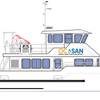I know it is hard to believe but soon the cool winds of Autumn will be blowing. With the change in weather, heaters will be fired up and newspapers will fill with tragic tales of carbon monoxide poisoning. If this is a typical year, nearly 300 people will lose their lives to this "silent killer" and 5,000 people will require hospitalization from its toxic effects.
Carbon monoxide is created by the inefficient combustion of carbon-based fuels such as gasoline, diesel, propane, natural gas, charcoal, and wood. These fuels can be found in virtually every home and every work setting. Carbon monoxide is a potential hazard in at your house, aboard vessels, and in poorly ventilated work areas in shipyards.
One reason CO is a particularly hazardous gas is it is difficult to detect with the senses. Carbon monoxide is a colorless, odorless gas causing symptoms easily mistaken for the flu or other common illnesses. Symptoms associated with exposure include:
· Headaches;
· Dizziness;
· Weakness;
· Sleepiness;
· Nausea;
· Vomiting;
· Confusion;
· Disorientation;
· Loss of consciousness; and
· Death.
The severity of systems vary with concentration, duration of exposure, frequency of exposure and personal risk factors, such as body mass, chronic disease, and age. Generally, the more CO an individual is exposed to, the more intense their symptoms will be. As far as personal risk factors are concerned, people in poor health and children are most susceptible to CO poisoning.
The harmful effects of CO are produced by gas chemically bonding to the hemoglobin in the red blood cells, thereby interfering with oxygen uptake. Once the CO has reacted with the hemoglobin, it is difficult for it to be displaced by oxygen. As more and more hemoglobin reacts with CO, chemical asphyxiation develops.
Although CO cannot be detected by the senses, there are several clues that may indicate potentially harmful CO concentrations, including:
Unfamiliar or burning odor;
Increased condensation inside windows; or
An appliance or engine that keeps shutting off .
Many types of equipment have safety components attached to prevent operation if an unsafe condition exists. If an appliance or engine stops operating, it may be because a safety device is preventing a dangerous condition.
Although these clues may suggest a CO problem, they are not reliable indicators.
The only reliable way to identify harmful CO concentrations is with a CO detector. CO detectors come in two basic varieties: colormetric and electronic.
Colormetric detectors are most suitable for spot-checking areas where CO is suspected and cost is an issue. This type of detector is usually designed for a single-use and is not equipped with an alarm.
Electronic CO detectors are designed for continuous detection, and they sound an alarm when a harmful concentration is detected. These are available as fixed or portable units. Fixed units should be mounted close to regularly inhabited areas such as engine rooms, offices, and bedrooms. In marine settings, I recommend electronic CO detectors be placed in engine rooms and living quarters. The fixed CO detector unit does not require mounting at a particular elevation, since CO tends to diffuse in air rather than stratify.
A common mistake people make with electronic CO detectors is to assume when the warning sounds it is a false alarm. If the alarm activates, assume the atmosphere is hazardous until proven otherwise. This means evacuating personnel and increasing ventilation by opening windows and doors.
CO detectors are the last line of defense. Action should be taken to prevent hazardous concentrations of CO from occurring in the first place.
One way to avoid creating hazardous accumulations of carbon monoxide is by the proper maintenance, installation, and use of heaters and internal combustion engines.
Fuel-fired heating appliances, including water heaters and gas dryers, should be thoroughly inspected by a qualified technician at least annually. They should be checked to ensure they have been properly installed in accordance with the manufacturer's recommendations. Adequate ventilation must be provided to assure exhaust is allowed to escape and to supply enough air for efficient combustion.
Special attention should be paid to appliances equipped with a chimney or flue. These should be checked for improper connections, loose connections, blockages, and corrosion, which may cause CO to accumulate in habitations. Sooting, rust stains and excessive smoke may also indicate inefficient combustion, which results in the creation of higher than normal concentrations of CO.
Equipment powered by internal combustion engines should periodically be inspected by a qualified technician to identify any problems that might create high CO concentrations. Engines must be properly tuned to minimize the amount of CO created. Also, the exhaust system must be carefully inspected for the same types of deficiencies as a chimney or flue on a gas heater.
Remember, even well-maintained, mobile equipment, powered by internal combustion engines will create toxic concentrations of CO if operated in a poorly ventilated area. Each year, scores of CO exposure incidents occur as a result of using diesel-powered forklifts in warehouses with an inadequate air exchange.
Sponsored Content
Lower carbon intensity fuels to support your operations

Subscribe for
Maritime Reporter E-News
Maritime Reporter E-News is the maritime industry's largest circulation and most authoritative ENews Service, delivered to your Email five times per week










